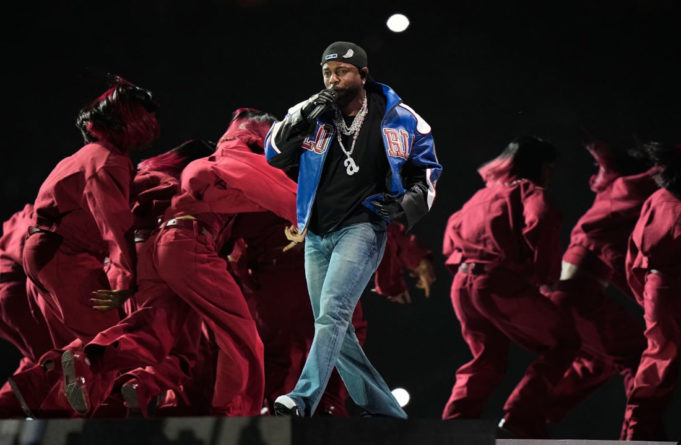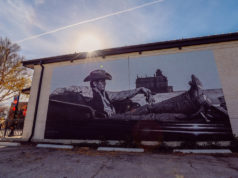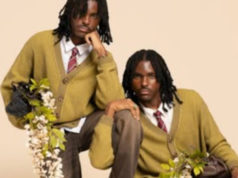I’m no sports fan, but like 127.7 million other Americans, I watched Super Bowl LIX. Those already a six-pack deep into the afternoon may have taken Kendrick Lamar’s controversial halftime performance as simply unpatriotic. However, the 37-year-old Los Angeles rapper won a Pulitzer Prize in music, so there’s more to him than just slick rhymes and baggy bell bottoms.
In many ways, his performance was a protest that may take years to fully unpack. For claiming to be just a musician, he always has a lot to say. Near the beginning of the show, Lamar growled, “The revolution is about to be televised,” referencing Gil Scott-Heron’s poem “The Revolution Will Not Be Televised” from 1971. “You picked the right time but the wrong guy.” Did he mean Trump? The rapper has previously criticized the president in songs like “The Heart Part 4” and “XXX.” Or was Lamar merely saying he was not going to be playing by broadcast rules? Either way, it was nearly impossible to look away at this point.
The stage layout was partially a PlayStation controller and also an homage to Squid Game, perhaps symbolizing the rich killing the poor. The stage, where his all-Black performers harmonized while he rapped, also supposedly represented a prison yard. Given the mass incarceration of Black Americans, it wasn’t necessarily shocking for Lamar to tackle this topic. He has many times before. It’s a prison yard in a game controller, for Christ’s sake! Reading it as two different kinds of prisons — one of the mind and one of the body — introduces just more juicy subtext … which most of us may have overlooked at the time.
Cue: the best MC ever.
Samuel L. Jackson’s Uncle Sam was not unlike his Sambo-type house slave in 2012’s Django Unchained. On record, Kendrick often eviscerates the concept of Uncle Sam, an ominous figure who exploits Black people through capitalism. Some theorize that this Uncle Sam warning Kendrick to “play the game” and “not be ghetto” was a veiled warning to play the game that white America wants Blacks to play. When Uncle Sam says, “This is the great American game,” he’s not just talking football.
Obviously, the dancers in red, white, and blue represented the American flag. In fact, at one point, they actually formed one sans any white stars. Coincidence? I’m thinking not. Lamar dancing through the middle of the human flag signified a divided country. Black vs. white? Rich vs. poor? Both. The line “40 acres and a mule, this is bigger than the music” from his song “Wesley’s Theory” alludes to what was promised (but not delivered) to freed slaves after the Civil War. They’re still waiting.
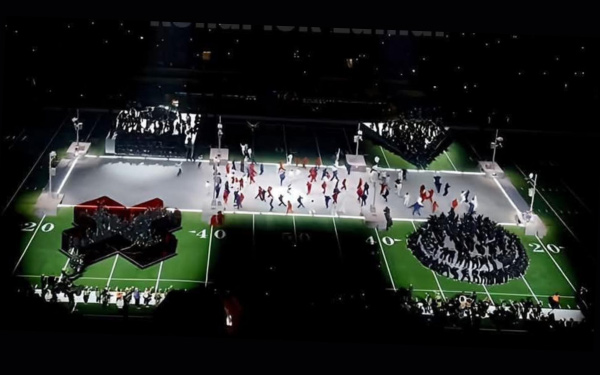
Courtesy Facebook
Lamar also performed “Not Like Us,” his diss track of Drake, with whom he has an ongoing beef. In the song, Lamar reminds us of how very different the people in power are from most Americans. Onstage, he also called out the Canadian rapper by name for his alleged associations with pedophilia and Sean “Diddy” Combs.
Serena Williams’ special appearance during this song wasn’t just about her giving the middle finger to her ex, Drake, who insulted her husband in a rap in 2022. It was also a statement about how Black people are expected to act/perform in public. Doing the Crip Walk nearly got her banned from Wimbledon a few years back. So, yes, bring it to the world stage.
Another song, “TV Off,” addresses revolution — which Lamar insists is not his thing, evidence to the contrary — in the wake of police brutality and may also be considered a call to action. The world is in crisis. Turn off your TV and do something.
From a purely theatrical perspective, OnStage Blog thought the performance was appreciated and well-received by theater aficionados. “Kendrick Lamar’s show was a celebration of the art form’s power to convey complex stories and evoke deep emotional responses, reaffirming the timeless connection between music and theater.” I couldn’t agree more.
It’s amusing to me how people either overanalyze or oversimplify these types of performances. Sure, Jay Z’s production company has been in charge of choosing the entertainment for the halftime show for several years now. With Jay Z and Beyonce supposedly part of the Illuminati, are there nods to that? Dig deep enough and use your imagination, and I’m sure you’ll come up with something. Meanwhile, the right-leaning people on my social feeds are focused on over-simplification at the moment.
No, I’m sure your favorite bro-country band would never agree to use tracks, so go ahead and dismiss this as not “real” live music and get on with your privileged lives. Music aside, every bit of Lamar’s vocals on Super Bowl Sunday were live, not tracks. He rapped seamlessly while dancing the distance of nearly half a football field. (Do you hear that? It’s the sound of 150 people unfriending me. Bye, y’all!)
While I do have some rap music on my playlist, my knowledge of the genre is pedestrian at best. Good thing Fort Worth Weekly Music Awards nominee DJ Dogstyle is here to help. He thinks that Kendrick is the first artist in a long time to rap about what’s actually going on in the world. “I definitely think he is Public Enemy, Paris, and NWA rolled into one being. The Super Bowl was a wake-up call for these young rappers to stop talking about getting high and killing each other.”
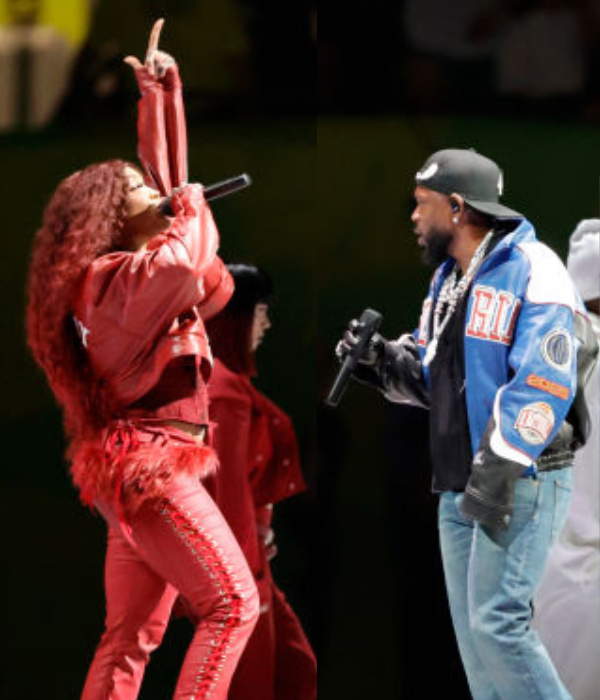
Courtesy Live Nation
Eve Rojas of 4 Ya Soul, winner of the Music Awards’ hip-hop/R&B category in 2023, thought it was the simplest yet most powerful halftime show she’d ever witnessed. “It symbolized so many issues we are dealing with in current America. Everything was good, from start to finish. [Guest artist] SZA did her thing, vocals on 100! Did you notice the guys just chilling on the light pole the entire show?!” Indeed, we did. The use of streetlights was reminiscent of the scene in his video for “Alright,” in which Lamar stands atop one before being shot by police.
Another Music Awards nominee, Complete the Emcee, thought the performance was powerful and insightful. “Kendrick is a brilliant artist who chose that huge platform to address issues. The issues are those that we have still and have had historically based on racial differences and/or indifferences. Kendrick combats the conditioning we have been exposed to, where we are all conditioned to feel a derogatory way about people of color. That’s not right!”
Our sports columnist Patrick Higgins also had some great insights last week. “Kendrick Lamar’s poignant and ambitious halftime performance delivered on the requisite Boomer discomfort. No doubt the socials exploded with angry comments from accounts whose profile pics consist of closeups of the users in their driver seats with wraparound Oakleys on.”
Those with a new or renewed interest in Lamar will be happy to learn that Arlington is the third stop on his upcoming Grand National Tour with fellow Super Bowl performer SZA at AT&T Stadium (1 AT&T Way, Arlington, 817-892-4000) at 7pm on Sat, Apr 26. This show has already been on sale for a while, but there are resale tickets available on Ticketmaster.com starting at $200 apiece.
Rob Brezsny’s understanding of revolution is different from that of some people. Read his thoughts on Incremental Revolution in Bulletin Board



